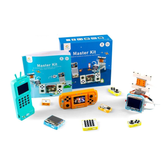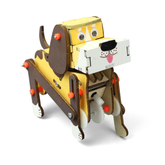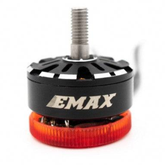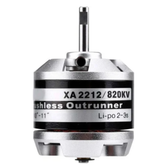-
A2212 1000KV BLDC Motor for RC Drones and QuadcoptersA2212 1000KV BLDC Motor for RC Drones and Quadcopters This A2212 1000KV Brushless Motor for Drones designed for quadcopters and multi-rotors. It has exceptional performance, superpower, and efficiency. These motors are ideal for medium-sized quadcopters with propellers ranging from 8 to 10 inches in...
- Rs. 371
Rs. 499- Rs. 371
- Unit price
- per
Save Rs. 128 -
A2212 1400KV BLDC Brushless MotorA2212 1400KV BLDC Brushless Motor Build powerful and efficient quadcopters with the A2212 1400KV BLDC (Brushless DC) motor, designed specifically for quadcopters and multirotors. This motor offers exceptional performance and efficiency, ensuring a satisfying flight experience. Its solid metal case ensures durability and reliability,...
- Rs. 379
Rs. 519- Rs. 379
- Unit price
- per
Save Rs. 140 -
A2212 2450KV BLDC Motor for RC Drones and QuadcoptersA2212 2450KV BLDC Motor for RC Drones and Quadcopters This is A2212 (BLDC) Brushless DC Motor of 2450KV, a high-speed brushless motor designed specifically for Quadcopters, Drones, or toy planes. This brushless DC motor is an outrunner-type motor, which means that the outside case...
- Rs. 400
Rs. 725- Rs. 400
- Unit price
- per
Save Rs. 325 -
3.7v 716 Magnetic Micro Coreless CCW Motor for Drone Quadcopter3.7v 716 Magnetic Micro Coreless CCW Motor for Drone Quadcopter The 716 Magnetic Micro Coreless Motor for RC Drone Quadcopters is a very compact and lightweight DC motor nicely crafted for perfectly matching with your small 100mm like multirotor frames. The 7x16mm CCW lightweight brushed DC...
- Rs. 289
Rs. 493- Rs. 289
- Unit price
- per
Save Rs. 204 -
RS2205 2300KV Brushless DC Motor for FPV Racing Drone Black Cap (CW Motor Rotation) - RS2873/RS4665RS2205 2300KV Brushless DC Motor for FPV Racing Drone CW Motor Rotation If you want to give your FPV racing drone a real upgrade, then we have the perfect solution for you. Check out the latest RS2205 2300KV Brushless DC Motor for FPV —...
- Rs. 659
Rs. 999- Rs. 659
- Unit price
- per
Save Rs. 340 -
Emax MT2213 920kva Brushless Motor with 1045 Propeller (1 pair)Emax 2213 920kva Brushless Motor with 1045 Propeller (1 pair) The Emax 920kva brushless drone motor comes with an adapter that is specially made to adjust the rotation of propellers in the CCW (counter-clockwise) direction. Multi-Rotor Brushless Motor MT2213-920kva is excellent and designed for Multirotor fast...
- Rs. 1,332
Rs. 1,607- Rs. 1,332
- Unit price
- per
Save Rs. 275 -
1800 KV BLDC Motor1800 KV BLDC Motor A2212/13T 1800 KV Brushless DC Motor is the perfect solution for hobbyists and professionals involved in RC aircraft and multi-copper projects. This high-performance motor is designed for quadcopters, RC cars, helicopters, airplanes, and more. Crafted with advanced BLDC technology, it...
- Rs. 414
Rs. 499- Rs. 414
- Unit price
- per
Save Rs. 85 -
930 KV BLDC Motor930 KV BLDC Motor The A2212 930kV Brushless Motor is the ultimate choice for quadcopter enthusiasts seeking high-performance and reliability. Specifically designed for quadcopters and multi-rotors, this 930kV motor delivers exceptional power and efficiency. Crafted with precision, the motor boasts a versatile compatibility, making...
- Rs. 489
Rs. 599- Rs. 489
- Unit price
- per
Save Rs. 110 -
Emax ECO II 2807 1300KV 3–6S High Performance Brushless Motor for RC DronesEmax ECO II 2807 1300KV 3–6S High Performance Brushless Motor for RC Drones The Emax ECO II 2807 1300KV Brushless Motor is a powerhouse engineered for FPV racing, freestyle, and long-range drone enthusiasts seeking the perfect blend of performance and reliability. This brushless motor...
- Rs. 1,752
Rs. 2,399- Rs. 1,752
- Unit price
- per
Save Rs. 647 -
EMAX ECO II Series 2807 1700KV Brushless Motor for FPV Long Range DronesEMAX ECO II Series 2807 1700KV Brushless Motor for FPV Long Range Drones The EMAX ECO II 2807 1700KV Brushless Motor is a next-generation brushless motor for drone enthusiasts who demand power, precision, and reliability. Built with a redesigned rounded structure and reinforced components,...
- Rs. 1,752
Rs. 2,499- Rs. 1,752
- Unit price
- per
Save Rs. 747 -
EMAX ECO 1106 4500KV CW Micro Brushless Motor for FPV Racing RC DroneEMAX ECO 1106 4500KV CW Micro Brushless Motor for FPV Racing RC Drone The EMAX ECO 1106 4500KV CW Micro Brushless Motor redefines performance for 2-inch FPV racing drones. Designed for enthusiasts who demand speed and precision, this micro brushless motor offers incredible power...
- Rs. 1,359
Rs. 1,899- Rs. 1,359
- Unit price
- per
Save Rs. 540 -
EMAX RS2205 2-4S Race Spec 2600KV Brushless Motor KitEMAX RS2205 2-4S Race Spec 2600KV Brushless Motor Kit The EMAX RS2205 2-4S Race Spec 2600KV Brushless Motor Kit is designed for drone enthusiasts who demand superior speed and control. This high-performance brushless motor for drone setups delivers powerful thrust and remarkable efficiency, making...
- Rs. 14,599
Rs. 23,199- Rs. 14,599
- Unit price
- per
Save Rs. 8,600 -
EMAX RS2205 2300KV 2-4S Race Spec Brushless Motor Kit for DronesEMAX RS2205 2300KV 2-4S Race Spec Brushless Motor Kit for Drones The EEMAX RS2205 2300KV Brushless Motor is a powerful and efficient brushless motor for drone applications, especially suited for FPV racing drones that demand speed and precision. Built with high-quality materials, it ensures...
- Rs. 14,499
Rs. 22,999- Rs. 14,499
- Unit price
- per
Save Rs. 8,500 -
EMAX ECO II 2004 2400KV Brushless Motor for FPV Racing DronesEMAX ECO II 2004 2400KV Brushless Motor for FPV Racing Drones The EMAX ECO II 2004 2400KV Brushless Motor is a powerful and efficient brushless motor for drones, engineered specifically for 3–4 inch FPV racing and freestyle builds. Upgraded from the original ECO series,...
- Rs. 1,899
Rs. 2,699- Rs. 1,899
- Unit price
- per
Save Rs. 800 -
EMAX 2207 1750KV Pulsar LED Brushless MotorEMAX 2207 1750KV Pulsar LED Brushless Motor The EMAX 2207 1750KV Pulsar LED Brushless Motor is engineered for drone enthusiasts who demand both power and style. As part of EMAX’s ECO II Series, this high speed brushless motor delivers exceptional performance, durability, and efficiency....
- Rs. 2,499
Rs. 2,899- Rs. 2,499
- Unit price
- per
Save Rs. 400 -
Emax RS2306 2550 KV White Edition Race Spec MotorEmax RS2306 2550 KV White Edition Race Spec Motor The Emax RS2306 2550 KV White Edition RaceSpec Motor is a high-performance brushless motor engineered for drone racers demanding top-tier power and precision. Building on the success of the RS2205-S, it features a lighter bell,...
- Rs. 2,299
Rs. 2,999- Rs. 2,299
- Unit price
- per
Save Rs. 700 -
EMAX XA2212 820KV Outrunner Brushless DC Motor for MultirotorsEMAX XA2212 820KV Outrunner Brushless DC Motor for Multirotors The EMAX XA2212 820KV Outrunner Brushless DC Motor is a high-performance motor built for drone enthusiasts seeking power, precision, and reliability. Crafted with premium bearings and high-quality silicone steel, this outrunner brushless motor delivers smooth,...
- Rs. 1,449
Rs. 1,899- Rs. 1,449
- Unit price
- per
Save Rs. 450 -
EMAX ECO Micro 1106 6000KV CW Brushless Motor for FPV Racing DronesEMAX ECO Micro 1106 6000KV CW Brushless Motor for FPV Racing Drones The EMAX ECO Micro 1106 6000KV CW Brushless Motor is a compact powerhouse built for FPV enthusiasts and drone racers who demand speed and reliability. This mini brushless motor is designed specifically...
- Rs. 1,425
Rs. 1,999- Rs. 1,425
- Unit price
- per
Save Rs. 574 -
A2212 1400KV BLDC Motor and Simonk 30A ESC with 1045 Propellers for RC DronesA2212 1400KV BLDC Motor and Simonk 30A ESC with 1045 Propellers for RC Drones The product pack features a 1400kv brushless motor, SimonK 30A ESC, and a set of 1045 propellers. The 1400KV brushless motor for drones and quadcopters is constructed with a solid...
- Rs. 799
Rs. 1,064- Rs. 799
- Unit price
- per
Save Rs. 265 -
A2212 2200Kv 6T Brushless Outrunner Motor Aircraft Quadcopter HelicopterA2212 2200KV 6T Brushless Outrunner Motor Aircraft Quadcopter Helicopter The A2212 2200Kv BLDC motor is a brushless outrunner motor specifically made for quadcopters and multi-rotors. It provides high performance, superpower, and brilliant efficiency. These brushless DC motors are perfect for medium-sized quadcopters with 8-inch...
- Rs. 371
Rs. 599- Rs. 371
- Unit price
- per
Save Rs. 228

Best Price Guarantee

Ready Stock for Bulk Purchase

Dedicated Account Managers

5% GST Benefits for Eligible SEZ and Edu

Technical Support Available

1-Year Manufacturer Warranty





















































